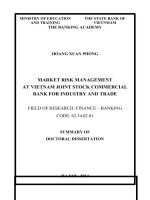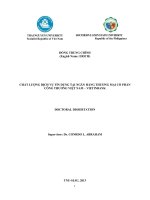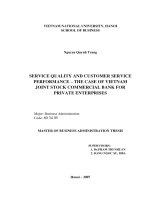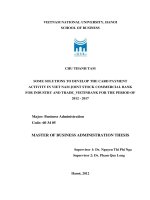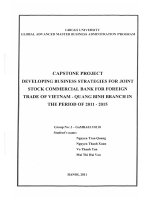Research about job satisfaction relative to expectations of BIDV joint stock commercial bank for invement and development of vietnam
Bạn đang xem bản rút gọn của tài liệu. Xem và tải ngay bản đầy đủ của tài liệu tại đây (1007.98 KB, 53 trang )
RESEARCH PROJECT
(BMBR5103)
RESEARCH ABOUT JOB
SATISFACTION RELATIVE TO
EXPECTATIONS OF BIDV
(Joint Stock Commercial Bank for Investment and
Development of Vietnam)
STUDENT’S FULL NAME
: VO THI LAN ANH
STUDENT ID
: CGS00019890
INTAKE
: 9/2015
ADVISOR’S NAME & TITLE : DBA.NGUYEN THE KHAI
March 2017
Page 1
Advisor’s assessment
....................................................................................................................................................................
....................................................................................................................................................................
....................................................................................................................................................................
....................................................................................................................................................................
....................................................................................................................................................................
....................................................................................................................................................................
....................................................................................................................................................................
....................................................................................................................................................................
....................................................................................................................................................................
....................................................................................................................................................................
....................................................................................................................................................................
....................................................................................................................................................................
....................................................................................................................................................................
....................................................................................................................................................................
....................................................................................................................................................................
....................................................................................................................................................................
....................................................................................................................................................................
....................................................................................................................................................................
....................................................................................................................................................................
Advisor’s signature
Page 2
Assurance
I hereby pledge to the paper "Assessment of Job Satisfaction of Employees
in BIDV" is my own research. The figures in this topic are collected and used
honestly. The results of the study presented in this dissertation are not copied by
any dissertation and any text and has not been presented or published in any other
research before.
Page 3
Thank you
First of all, I would like to send my sincere thanks to the teachers of the
University of Technology, who have taught me and taught me the precious
knowledge that underlies this thesis. I would like to thank Dr. Nguyen The Khai,
who has guided me and instructed me to complete my dissertation research. I also
sincerely thank all colleagues at BIDV for helping me answer the survey
questionnaire as a source of data for analysis and results of this thesis. Finally, this
dissertation is completed with the support and help of friends and family members.
I would like to thank everyone!
Page 4
Contents
Abstract ............................................................................................................................................. 1
I.
BIDV INTRODUCTION ........................................................................................................ 3
1.1
About company ................................................................................................................. 3
Scope of business .......................................................................................................................... 3
Position .......................................................................................................................................... 4
Human resources ........................................................................................................................... 4
Customers base .............................................................................................................................. 5
1.2 Organizing ............................................................................................................................... 5
1.3 Research problem .................................................................................................................. 10
1.4 Research Object ..................................................................................................................... 11
1.5 Research scope ...................................................................................................................... 11
1.6 Signification .......................................................................................................................... 12
II.
THE RATIONALE AND PRACTICE OF EMPLOYEE SATISFACTION
RESEARCH ................................................................................................................................... 14
2.1 Satisfaction ............................................................................................................................ 14
2.2 Employee satisfaction of the business ................................................................................... 15
2.3 Research methods on satisfaction .......................................................................................... 17
2.3.1 Research by Foreman Facts ........................................................................................... 17
2.3.2 Research by Weiss, Dawis, England & Lofquist ............................................................ 17
2.3.3 Research by Smith et al .................................................................................................. 18
2.3.4 Schemerhon's study......................................................................................................... 18
2.3.5 Spector's research........................................................................................................... 18
2.3.6. Comparison of research models .................................................................................... 19
2.4 Overview of satisfaction of works and factors affecting work satisfaction ........................... 20
2.4.1 Herzberg's Two-Factor Theory (1959)........................................................................... 20
2.4.2 Abraham Maslow's Theory of Needs (1943) ................................................................. 21
2.4.3 Like Maslow's hierarchy of needs theory ....................................................................... 21
2.4.4 Victor Vroom's Expectancy Theory (1964)..................................................................... 21
III.
METHODS RESEARCH.................................................................................................. 22
3.1 Data collection ....................................................................................................................... 22
3.2 Models and discussion studies on satisfaction of employees ................................................ 26
Page 5
3.2.1 Recommended research model ....................................................................................... 26
3.2.2 The hypothesis of the research model proposed ............................................................. 32
3.2.3 Data collection progress ................................................................................................ 34
IV.
RESULT ............................................................................................................................. 35
4.1 Scale rating by Cronbach Alpha ............................................................................................ 35
4.2
V.
Exploratory factor analysis – EFA .................................................................................. 36
CONCLUSIONS .................................................................................................................... 41
5.1 Discussion.............................................................................................................................. 41
5.2
Restructuring of research and forecast recommendation................................................. 44
REFERENCES ................................................................................................................................ 46
Page 6
Abstract
It can be said, at present, one of the competitive elements between These
businesses are the policy to attract talent. Bring about Satisfaction for employees
becomes more urgent than ever by it Also for the important purpose in the present
context is to keep staff. To find out the level of satisfaction of banking industry
employees for their business and their business is empowering and help banks have
a basis to assess the value of their HR policies and corporate image for Labor
market
For BIDV - a bank focused on exploiting strengths in the human element satisfying both internal and external customers is considered one of the key tasks in
the context of fierce competition.
The open market economy has opened up more and more employment
opportunities for foreign workers to enter the country. In addition, there are many
challenges in human resources such as shortage of middle and high level labor
force, labor quality, competitive salary and wage scandal scandal scandal. . Human
resources are an important factor for the success of a business, because, according
to experts, competitors can "clone" their strategies, business practices, products and
services. "Copy" is. However, the current recession has led to shrinking revenue,
shrinking markets, resulting in many human resources problems.:
The rate of brain drain, jumping high: Job hopping is increasing (10-13%
per year.
Page 1
Strike labor increased, resulting in many consequences such as:
Manufacturing stagnation does not reach the plan, reputable business damage ...
Productivity and performance decrease: The cause may be due to a lack of
confidence in the company's new policy, organizational change, employees feeling
insecure about their future ...
In the era of economic integration, the competitiveness is increasingly fierce,
human resources play an important role in creating competitive advantage.
Especially with the development companies like BIDV, want to confirm their
position in the market, the more attention must be paid to the satisfaction of
employees. Therefore, this research was conducted to "Study the satisfaction of
employees at BIDV". The research results will help the company to have a
scientific basis for the development and implementation of appropriate human
resource policies, to overcome difficulties in the current workforce, improve the
economy with banks in the region and in the world.
Page 2
I. BIDV INTRODUCTION
1.1 About company
Company introduction
BIDV was established on 26 April 1957 as the Bank for Construction of
Vietnam. From 1981 to 1990, it changed its name to the Bank for Investment and
Construction of Vietnam. In 1990 the bank adopted new name as Bank for
Investment and Development Vietnam and had operated under this name until 2012.
Since April 27th 2012 to present, it officially has become Joint Stock
Commercial Bank for Investment and Delopment of Vietnam.
Addess of head office:
BIDV Tower, No. 35 Hang Voi Street, Hoan
Kiem District,
Hanoi Capital, Vietnam.
Email:
Scope of business
Banking: BIDV has a wealth of experience in Vietnam, providing a full
range of modern and convenient banking products and services including deposits,
Page 3
loans, trade finance, payment and account services, and card services and among
others.
Insurance: BIDV provides life and non-life insurance product bundles,
tailored to the needs of individual customers.
Securities: BIDV provides a wide range of brokerage services, investment
consultancy with the ability of quickly developing a system of order receiving
agents nationwide.
Financial investment: BIDV contributes capital to establish companies for
investment in key national projects and takes the lead in a number of significant
projects such as Vietnam Aircraft Leasing Company.
Position
BIDV is always at the forefront of implementing major economic and
monetary policies of the Government and the State Bank of Vietnam. BIDV’s total
assets, outstanding loans and deposits in 2015 were higher than those of key
competitors, making it the leading bank among commercial banks.
Human resources
With 24,000 officers, employees and financial consultants who are wellqualified and well-trained with full experience and have been accumulated and
Page 4
transferred for over half of a century, BIDV always brings its customers the
benefits and reliability.
Customers base
Corporates: BIDV has established relations with nearly 200,000 corporate
customers including groups, corporations, and small and medium-sized enterprises
from all economic sectors.
Financial institutions: BIDV has established correspondent relationships
with nearly 1,700 financial institutions both local and international. The bank is the
trusted choice of major international organisations including the World Bank, ADB,
JBIC and NIB.
Individuals: 7.7 million individual customers currently use products and
services of BIDV.
1.2 Organizing
Page 5
Organization Structure
BIDV Organization chart
Page 6
Organization chart of Head
Page 7
Headquarters are categorized into 7 functional blocks: Block wholesale
banking; Retail banks and networks; Block Capital Capital; Blocks of risk
management; Operational block; Bloc Bloc Finance and Accounting support. At
branches are arranged into five blocks: Block customer relationship; Blocks of risk
management; Operational block; Block internal management and Subsidiaries.
New organizational model works well as an important platform for the Bank
towards becoming a modern retail banking.
Along with the restructuring of the organizational structure, the management
system has also been continuously strengthened, enhanced, consistent with
organizational models and new development requirements. Bank for Investment
and Development has developed and perfected institutional development plans,
issued the basic full text systems business, create uniform legal framework for
banking activities according to the law, in line with standards and international
practices.
HUMAN RESOURCE
With more than 18,000 officers, employees and financial consultants who
are well-qualified and well-trained with full experience and have been accumulated
and transferred for over half of a century, BIDV always brings its customers the
benefits and reliability.
In particular, there are 300 staffs with full training according requirement of
business and operation at Card Centre. With strong and skillful manpower of
Page 8
BIDV, it enhances competitiveness with leading banks and foreign banks in
Vietnam.
Continue to promote the values of corporate culture, especially the Ministry
issued two standards of professional ethics and code of conduct was issued in 2009,
the common practice in the entire system. In the spirit of the core of the Bank's
standards of conduct HONESTY - FRIENDLY - ADVANCED, or 6 "golden
letters" in dealing with customers is: FRIENDLY - HEARTED - ADVANCED, so
far, the Bank has 1.8 thousand highly qualified staff who have the qualifications,
skills and high professionalism.
Together, recruitment, staff rotation to training combines risk management;
activity test, internal monitoring also contribute to the Bank has a highly qualified
staff of top quality banking and financial markets at present.
Focus focus on improving the quality of assets and human resources BIDV
always identified as an important task, is the determining factor to promote the
value of internal resources, decisions on quality, sustainable efficiency BIDV's
operations.
Management model and corporate governance systems and institutions are
the World Bank international consultants implementation consultants such as
governance capacity building strategic management; Credit management; Enhance
operational risk management oriented Basel 2
Page 9
BIDV always adequate attention to material life, the spirit of the employees.
Besides the continued fostering of core staff for the sector, training and retraining
of staff, BIDV has constantly recruiting young workforce with the knowledge and
skills to meet the requirements of integration. The system has executed an
employment policy is relatively uniform, worthy remuneration and performance
capabilities of each individual to create an environment at the same time working
with the cultural competition, encourage creativity is a member of the ...
1.3 Research problem
Systematize reasoning about employee satisfaction
Establish a model for assessing the satisfaction of banking staff
Understand the factors that affect employee satisfaction and assess the
current status of employee satisfaction. From there, we propose solutions to
enhance the efficiency of banking management in the coming time.
The objective of the survey was to develop a database of employee
comments, study factors and aspects that affect the satisfaction of all employees, or
of a group of employees with the business. As a business trainer, management
levels are responsible for increasing the level of employee satisfaction. The first
step in increasing employee satisfaction is to survey the current situation.
Page
10
1.4 Research Object
Object: To study staff satisfaction based on the proposed model assessment
model.
Main aspects of the survey
• Personal capacity
• Working conditions
• Relationships in the workplace
• Tools and systems encourage employees
• Engagement with business
• Communication and feedback system
• Promotion opportunities
1.5 Research scope
Scope: employees of BIDV in Ho Chi Minh city at the time of research (late
2016 in early 2017)
Spatial scope: Study of staff satisfaction in departments
Under BIDV
- Time range:
+ Secondary data: Collect information related to the process of formation
and operation
The company's footage, materials from the press, internet and college thesis.
Page
11
+ Primary data: Collected through live interviews of staff working at the
departments
- Content: Study on factors affecting employee satisfaction. On
This basis, propose solutions to improve employee satisfaction with BIDV
1.6 Signification
Complete the assessment of employee satisfaction
Contribute to enrich the company's harmony assessment system as well as
the basis for other banks to refer to the improvement of human resource
management.
As
a result of the employee satisfaction survey, employees can understand
more about employee or employee feedback as well as their contributions. Also
through these feedbacks, new perspectives are shared that may play an important
role in enhancing competitiveness or fostering business growth. In addition, the
employee satisfaction survey identifies aspects of business that need to be revised
and the direction of change, as well as helps the executive make the decision
regarding the business. Finally, surveys also help you build strong connections with
your employees, retain good employees, and attract talented people
Enhance your business competitiveness based on the efforts of highly
committed and dedicated employees.
Page
12
Employees who are satisfied with the job will have a high productivity,
indirectly increase profits for the business.
If a business does not care about internal satisfaction, it will be less
competitive than the competitor's investment in activities to increase employee
satisfaction.
Benefit from a satisfied staff
• Commitment, loyalty
• Increase personal productivity
• Increase the productivity of the whole organization
• Increase motivation to work
• Word of mouth advertising for businesses
Challenge from an unhappy employee
• Productivity is not stable
• Cause disputes
• Affecting corporate reputation
• Reduce motivation and work results
• Reduce company spirit
Page
13
II.
THE RATIONALE AND PRACTICE OF
EMPLOYEE SATISFACTION RESEARCH
2.1 Satisfaction
There are different concepts of satisfaction:
Satisfaction is the degree to which a person's sense of state is derived from
comparing the results obtained from reality with those expectations (Philip Kotler
2001).
Satisfaction is the human response to estimating the difference between
previous expectations and perceived reality (Tse and Wilton 1988).
According to Miller (1977), consumer satisfaction is the result of the effects
of expected levels of anticipation and actual assessments. From an analysis point of
view this is achieved by the formula:
When reality gets higher than expected then people are satisfied,
Conversely when the actual received is lower than expected, people feel
dissatisfied.
According to Vroom (1964), job satisfaction is a state in which workers are
clearly oriented towards organizational work.
Wexley and Yukl (1984) define job satisfaction as the way an employee
perceives his or her occupation.
Page
14
According to Spetor (1997), job satisfaction is simply how people feel like
their work and work aspects.
The definition of satisfaction relates to job components
According to Smith, Kendal and Huilin (1969), satisfaction with the
components or aspects of work is the attitude and influence of the employee on
different aspects of the job (job nature, opportunity Training and promotion,
leadership, colleagues, their salary)
2.2 Employee satisfaction of the business
Satisfaction is the satisfaction of need, desire, expectation. The needs, wants,
expectations are the driving force for human performance. Kusku (2003) states that:
Employee satisfaction reflects the degree to which individual needs and
expectations are met and perceived by other individuals. Employee Satisfaction
with Businesses expressed in the job is the employee's preference or dislike for the
job, which represents the employee's acceptance and satisfaction with the results
they receive. Was when doing the job. And most clearly expressed through their
engagement and loyalty to the business. When assessing satisfaction one not only
considers workers' reactions on aspects that directly affect workers without regard
to the results of employee satisfaction.
There are a number of factors that affect the level of employee satisfaction
for a business and each of the factors influencing employees may vary depending
on the motivation, expectations, expectations of each person. There are a lot of
Page
15
theories out there about which motives are more important or more influential for
employees in a business, such as Maslow's theory of demand and the two-factor
theory of F.Herzberg
In short: Satisfaction is the fulfillment of the needs and desires of the people
in the work environment. When the desired needs are met adequately, the
satisfaction of the workers is increased. Factors that affect employee satisfaction
with the business There are a number of factors that affect the level of employee
satisfaction in a company, such as: the nature of the work, remuneration and
welfare, promotion, corporate environmental, safety, health ... However, due to the
research scope of the topic, in order to facilitate the analysis, I only analyze the four
factors: work, training, training and promotion, wages and benefits. Enlightenment,
working environment, sense of attachment with the business.
Weiss's (1967) definition of satisfaction is broader and more inclusive: Job
satisfaction is the attitude of work expressed by the worker's feelings, beliefs and
behaviors.
Definition of satisfaction with job components Smith, Kendal and Huilin
(1969), Schemerhon (1993), Kreitner and Kinicki (2007) satisfaction with
components such as job characteristics, opportunities
Training
and
promotion,
leadership,
co-workers,
salary,
public
relations,Work, treatment, and rewards.
In short, employee satisfaction in the workplace is when they have a sense of
pleasure, comfort, and a positive response to their work aspects
Page
16
2.3 Research methods on satisfaction
2.3.1 Research by Foreman Facts
According to the approach of Foreman Facts (1946) the satisfaction The
staff involved ten factors: (1) ingenious discipline, (2) Empathy to individual
worker issues, (3) Work Interesting, (4) Being interacted and shared at work, (5)
TB safety (6) Working conditions, (7) Salary, (8) Fully assessed The work done, (9)
personal loyalty to the superior, (10) Advancement and career development.
2.3.2 Research by Weiss, Dawis, England & Lofquist
Weiss, Dawis, England & Lofquist (1967) built the tissue The Minnesota
Satisfaction Questionnaire (MSQ) consists of 20 items With 20 factors) evaluates
the overall level of satisfaction in each aspect:
(1) the ability to use (the opportunity to do something that can promote the
ability of workers); (2) Achievement (feeling of good accomplishment that the
employee gains from the job); (3)Active (can maintain busy for most of the time);
(4) promotion (promotion opportunities in this work); (5) Rights Term (opportunity
to tell others what to do); (6) Policy Company (how the company sets policies and
put into practice); (7) Compensation (salary and a large amount of work done); (8)
Colleagues (how colleagues show up to others); Creativity (the opportunity to try
individual approaches to his work); (10) independence (opportunity to work alone
in work); (11) Safety (stability of work); (12) social services (the opportunity to do
Page
17
something for others); (13) Social position (Opportunity to become "someone" in
the community); (14) moral value (can do things that are not contrary to
conscience); (15) recognition (praise when doing a good job); (16) Liability
(freedom of use of opinions); (17) Supervision - human (how executives lead the
staff); (18) Technical supervision (decision-making ability of leaders); (19)
Diversity (opportunity To do different things); (20) working conditions
2.3.3 Research by Smith et al
The Job Descriptive Index (JDI), set up by Smith et al in 1969, is one of the
most valued and credible scales in both theory and practice. This scale consists of
five elements:(1) the nature of work, (2) opportunities for promotion, (3) leadership,
(4) colleague, (5) salary. Later on, Crossman and Bassem (2003) added two more
components, welfare and working environment.
2.3.4 Schemerhon's study
Schemerhon (1993) outlines eight factors that affect employee satisfaction,
including: (1) job placement, (2) supervisory level, (3) Relationship with colleagues,
(4) Job content, (5) Treatment, (6)Advancement, (7) physical condition of working
environment, (8) organizational structure
2.3.5 Spector's research
Page
18
The Spector (1997) Job Satisfaction Survey (JSS) model was developed for
use in service businesses, including nine factors that measure satisfaction and
attitudes: (1) salary, (2) promotion opportunities, (3) working conditions, (4)
supervision, (5) coworkers, (6) job favorites, (8) surprise reward, (9) benefits
2.3.6. Comparison of research models
Weiss's model with colleagues and Foreman Facts is more detailed, but the
weakness is too long. Schemerhon and Spector proposed more neat models, but if
applied to practical research also need to be adjusted accordingly. The Smith et al.
Model of JDI does not yet outline the factors that affect satisfaction and does not
have an overall scale, but on the basis of this model there has been a great deal of
research for the results to be evaluated. High in value and reliability. Later, when
the authors Crossman and Bassem added two factors that made the model more
complete.
In Vietnam, the JDI model is also used by many authors as a basis for
employee satisfaction research, such as Tran Thi Kim Dung (2005) in the topic
"Demand, Tablet and degree of engagement with the organization, "used a sevenfactor scale; Vu Khac Dat (2009) measured the satisfaction of office workers of
Vietnam Airline in the South using a six-factor scale; Nguyen Tran Thanh Binh
(2009) carried out the employee satisfaction survey at Long An Mechanical
Machinery Joint Stock Company using a six-factor scale.
Page
19

